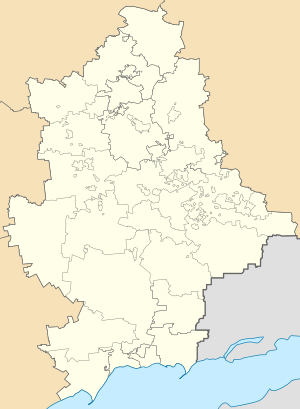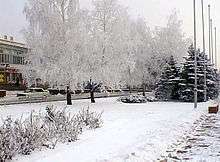Yenakiieve
Yenakiieve (Ukrainian: Єнáкієве, Yenakiieve; Russian: Ена́киево, Yenakiyevo), a city in the Donetsk Oblast (province) of eastern Ukraine, is incorporated as a city of oblast significance (a special status within the region equal to that of a raion (district)). The city stands on the Krynka River about 60 kilometres (37 mi) from the oblast's administrative center, Donetsk. Its population is approximately 79,348 (2017 est.)[1].
Yenakiieve Єнакієве | |
|---|---|
 Flag  Coat of arms | |
 Yenakiieve Map of Donetsk Oblast with Yenakiieve highlighted.  Yenakiieve Yenakiieve (Ukraine) | |
| Coordinates: 48°13′00″N 38°12′00″E | |
| Country | |
| Oblast | |
| City Municipality | Yenakiieve |
| Founded | 1898 |
| City rights | 1925 |
| Area | |
| • City of regional significance | 39.2 km2 (15.1 sq mi) |
| Population (2013) | |
| • City of regional significance | 82,629 |
| • Density | 2,653/km2 (6,870/sq mi) |
| • Metro | 129,932 |
| Time zone | UTC+2 (EET) |
| • Summer (DST) | UTC+3 (EEST) |
| Postal code | 86400—86470 |
| Area code(s) | +380 6252 |
| Climate | Dfb |
| Website | Verkhovna Rada of Ukraine |
.jpg)


.jpg)
Yenakiieve is an important regional centre of coal mining, metallurgy, chemical production and manufacturing. The city's outdated industry has caused accidents like that of a gas explosion which occurred in June 2008 at one of Yenakiieve's coal mines.
Yenakiieve was founded in 1898 when numerous workers' settlements around the Peter's Iron and Steel Works were united into a single settlement named after Fyodor Yenakiyev. Its first coal mines had dated from 1883. The settlement was incorporated as a city in 1925. By 1958, the city and factories had expanded significantly and overtook the out-lying villages of Simyukuo, Yevrah, and Tsiminyenny, all of which were resettled in their entirety when local livestock could not survive the expanding steel mills' runoff and pollution.
One of the oldest metallurgical factories of Ukraine—the Yenakiieve Iron and Steel Works—operates in Yenakiieve.
The city is known as the birthplace of the former President of Ukraine, Viktor Yanukovych (in office 2010–2014).
History
Permanent settlements on the territory of present-day Yenakiieve were founded in 1783. In 1858 Sofiyevsky coal mine was opened there. At the same time Petrovsky cast-iron plant was constructed (today Yenakiyeve Iron and Steel Works).
In 1895 engineers F. Yenakiev and B. Yalovetsky and several Belgian businessmen founded a Russian-Belgian metallurgic society which by 1897 constructed a new Petrovsky cast-iron plant around the settlement Fyodorovka. Coal mines were opened around the plant. Settlements were formed near them and in 1898 they were united into one called Enakievsky after the founder of the Russian-Belgian metallurgic society. The writer A. I. Kuprin who worked at the plant in 1896 described workers’ lives in the story “Molokh”. Before World War I several plants were built in Yenakiieve: coke chemical, brick, beer brewing and butter making. Petrovsky plant became one of the largest metallurgic plants (3rd place) in southern Russia. In 1913 it produced 349,200 tons of cast-iron and 316,400 tons of steel. As a result of ruin after World War I and Civil War of 1919–1921 Petrovsky plant was the only one producing steel. By 1925 the population in Yenakiieve was 34,000, it was referred to as a town.
In 1928 the town was renamed into Rykovo, after Soviet party- and statesman Alexei Rykov. After Rykov was arrested in 1937 and the town was renamed as Ordzhonikidze after another Soviet leader Sergo Ordzhonikidze. The name Yenakiieve was returned to the town in 1943. By 1939 the population of the town was 88,200.
During World War II Yenakiieve was under siege from Italian army auxiliary units that were seconded to the German Army. They were followed by German units. The city was attacked from 31 October 1941 and not freed until 3 September 1943. Street fighting was fierce between the end of November and beginning of December 1941. “Recruitment” of civilians (Ostarbeiter) began in December 1941. In 1950 about twelve Italian POWs (prisoners of war) were put on trial, over atrocities in Yenakiieve (including the destruction of a hospital). Apparently no convictions were registered, and by 1954 all Italian POWs were returned to Italy.
In the 1950s several plants were put into operation: of ferro-concrete items, of construction material, of house building and automobile-repairing. On September 16, 1979, on the territory of Yenakiieve in the mine “Yuny Communar” there was one of the Nuclear Explosions for the National Economy—an object “Klivazh”. In 2002 the mine was closed as non-perspective and environmentalists worry about the danger of filling the mine with water. It might cause radioactive pollution of the underground water. That's why pumps continue to pump the water out of the abandoned mine.
During the War in Donbass the city was captured by pro-Russian separatists[2] when on 13 April 2014 pro-Russian activists captured its town hall and declared that the city was part of the separatist Donetsk People's Republic.[3] (Only) the city suburb Vuhlehirsk stayed under control of the Ukrainian authorities.[4]
Demographics
At the time of the 2001 Ukrainian Census, the population of Yenakiieve was 104,000. Its composition was as follows:[5]
- Ethnicity
- Russians: 51.4%
- Ukrainians: 45.3%
- Belarusians: 1.1%
- Armenians: 0.4%
- Language
- Russian: 89.4%
- Ukrainian: 9.8%
- Armenian: 0.2%
- Belarusian: 0.1%
Yenakiieve City Municipality
- Yunokomunarivsk city municipality
- City of Yunokomunarivsk
- Town of Druzhne
- Karlo-Marksove town municipality
- Town of Karlo-Marksove
- Village of Novoselivka
- Settlement of Staropetrivske
- Korsun town municipality
- Town of Korsun
- Village of Verkhnya Krynka
- Village of Petrivske
- Village of Puteprovid
- Village of Shevchenko
- Settlement of Shchebenka
- Village of Avilovka
- Village of Shaposhnykove
References
- "Чисельність наявного населення України (Actual population of Ukraine)" (in Ukrainian). State Statistics Service of Ukraine. Retrieved 26 August 2017.
- A year after fighting stops, depressed Yenakiyeve waits for recovery under Russian occupation, Kyiv Post (June 24, 2015)
- (in Russian) As part of the People's Republic of Donetsk steel Zhdanovka and Kirov [map], Komsomolskaya Pravda in Ukraine (14 April 2014)
- (in Ukrainian) The Cabinet named the city of Donbass, under the control of separatists, Korrespondent.net (14 November 2014)
External links
| Wikimedia Commons has media related to Yenakiieve. |
- "City of Yenakieve, Donetsk Oblast". Verkhovna Rada of Ukraine (in Ukrainian). Retrieved 2008-06-09.